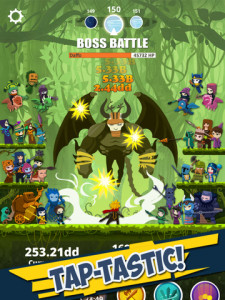Incremental Games are a recently recognised genre of video game that is popular on mobile phones and browser game sites such as Kongregate with the simple goal to earn as much ‘currency as possible. The currency itself can take many forms, but is basically an integer that is increased by performing a simple action, usually just by the click a of button or tap of the screen. Players have the option of spending their currency on powerups, these powerups usually have the effect of making the click/tap earn more gold but the powerups themselves get more costly over time. For example a click might earn a player 1 gold, but by spending 100 gold on a powerup clicks will then earn the player 2 gold. This means the player can watch his currency go up faster, but the powerup for ‘3 gold per click’ is now 200 gold.

In Tap Titans players get gold from killing monsters by tapping. The monsters get harder but the player can spend gold on stronger taps or damage per second warriors. (img source: Itunes store)
To mix it up a bit many games also have a currency per second powerup, this powerup does not affect the action that earns the player currency but instead earns the player currency over time. For example a player might pay 500 gold so they can earn 1 gold per second without actually doing anything, the next powerup might earn them 2 gold per second but costs 1200 gold. These powerups combine earning the player 3 gold per second! This adds a time element to the game, players can walk away and still their currency will increase.
I am extremely fascinated by the incremental games genre for many reasons, the games themselves rely on a Skinner Box method to keep people entertained, constant feedback of the currency earned keeps players playing even though the game is programmed for the powerup cost to rise in line with earnings forever, this means there is no end game as such, but players keep playing to see the number go up. The currency per second adds an element that the players time is worth something, players try to work out the most cost effective way of spending money on powerups that will earn them more when they are away.
The real kicker to incremental games is that players are willing to pay real money to get early access to the powerups. The incremental cost of the powerups is worked out by the developer so that at specific points in the game the player will find themselves with a choice – slog out the action for a long time, wait until the gold per second to come in or pay to get the powerup. Players are willing to pay not only because the skinner box method is so effective at keeping them engaged by also because the game is integrated in to Facebook/Google+ and is pitting players in a race to increase their integer. Incremental games are oppressive.
The education sector is now fully wrapped up in a computational theocracy in which an emerging pillar is the gamification of educational processes. The church of big data tells us exactly what students want because it has the holy dashboards to inform us. As game developers meet education in projects such as RAGE to apply games to education I think we really need to think hard about what we are doing to students when we gamify the educational experience. Big data talks a lot about ‘engagement rates’ and we see gamification as a way to increase them, but are players of incremental games truly engaged? What happens when we turn the currency in to assignments or degrees?
I am truly fascinated by idle games and I am sure the developers of such games have a different opinion to mine. To explore and experiment with the genre I’ve started to build a game myself (minus the paying to win!). I’ve picked Unity as my development environment and will video/blog about the process.



0 Comments